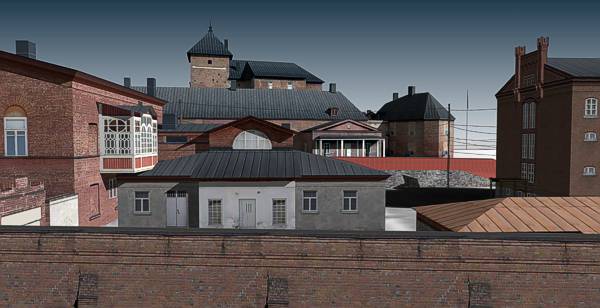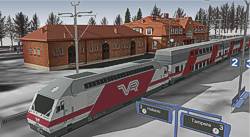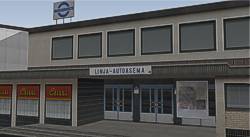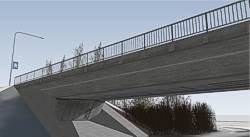

A couple years ago Google decided to end the open
geo-modeling
project for Google Earth. Here are some buildings made in that period
from the
city of Hameenlinna. A one entirety; Linnanniemi museum area is
viewable here.
Although Google's new method of visualizing
buildings and trees in
Google Earth has its sides, the "traditional" type of models that are
presented in this page, are far more realistic than those new Google
Earth buildings. In addition when viewed from a distance, they work as
well at very close range; not just flying above, it is possible to even
"walk" among them.
3D Models
VarksArt Hameenlinna 3D models are loadable free from SketchUp 3D
Warehouse to the SketchUp modeling application. To find and study these
models, click on the embed link in each image below. Along with the
terminated
geo-modeling project, some models stay unreleased.
 Hame Castle
Hame Castle
After Earl Birger's crusade in 1240, Sweden tightened its
grip on
Hame province. Younger son of Earl Birger, Maunu Ladonlukko, began the
construction work of the castle in late 1200 century. In
remain
documents, castle is mentioned for the first time as early as 1308. In
1350 the oldest grey stone structure was renewed by using bricks. The
canon tower was finished in 1559, and the crown bakery along the other
bailey buildings during the 1700 century. The castle has served also as
a granary and a prison. After the restoration between 1953-1988 the
castle has been open for public.
If you own 3D (red/cyan) goggles, you can make an anaglyph
journey to the castle area on this
friendly website.
 Hameenlinna Town Hall
Hameenlinna Town Hall
The
building is the fourth Town Hall in the history of Hameenlinna city. It
represents the Neo-Renaissance style and was drawn by the province
architect Alfred Cawén. The building was finished in 1888.
 Hameenlinna Art Museum
Hameenlinna Art Museum
Hameenlinna Art Museum operates in four adjacent buildings at
the
moment; in 1838 finished empire-styled main building (originally drawn
as a granary by architect C.L.Engel), in 1852 finished brick building
drawn by Ernst Lohrmann, timbered crown's stockhouse from 1820 and the
Pinella house (1906) as in museum's office use. Pinella's park is next
to the museum area.
 Hameenlinna Railway Station
Hameenlinna Railway Station
The first railway line in Finland was opened in 1862 between
Helsinki and Hameenlinna. The current station in Hameenlinna was built
after destruction of the original station during the Civil War in 1918.
The station was drawn by architect Thure Hellstrom and it was completed
in 1921.
An anaglyph journey on this
friendly website.
 Hameenlinna Church
Hameenlinna Church
The construction work of Hameenlinna Church was started after
the command by King Gustav the III in 1792 and by following the plans
of
architect Louis Jean Desprez. Original work was finished in late 1798.
In 1837 the bell tower was included to the sacristy. The church was
extended to its final cross-shaped form in 1892 after the plans of
architect Josef Stenback. Plaza Park next to church was finished in
1911 and it was drawn by architect Armas Lindgren.
 Vanaja Church
Vanaja Church
Vanaja
Church is a gray stone church built in late 1490's and the first decade
of the 16th century. Unfortunately this is one of those models remain
unreleased.
 Historical Museum
Historical Museum
In 2000 the Hameenlinna Historical Museum was moved from the
city center to its present location. The building was originally
constructed
in 1844 for Kronoborg labour and correction institution, and it was
drawn by architect A. F. Granstedt. During 1869-1993, the building was
used as prison.
 Museum Militaria
Museum Militaria
The Cannon Museum of Hameenlinna (Hameenlinnan Tykkimuseo) was combined
with
two other military museums in January 2013.
 Prison Museum
Prison Museum
From its inauguration in 1871 the building was Finland's
first prison with separate cells. The prison use was ended in 1993 and
in
1997 the building was opened as a museum. The building was drawn by
architect L. I. Lindqvist.
 City Library
City Library
The Public Library of the City of Hameenlinna was drawn by
architect Heikki Aitola and it was finished in 1983. Library cafe
Novelli and the
city archives are also in the building. Two parks are surrounding the
library; Maaherranpuisto in the northeast and Aleksis Kivi park in the
northwest.
 Block 10
Block 10
The old Government House of Hameenlinna city is surrounding
by two condominium buildings (Sibelius street 4 and Hallitus street 14)
and two office buildings (Birger Jaarli's street 13 and the Territory
Administration Office of Southern Finland).
 Bus Station
Bus Station
The
station was constructed in 1958 after plans by architect Olavi Sahlberg.
 Fire Brigade Building
Fire Brigade Building
(Palokunnantalo).
Old fire station.
 Palokunnankatu 16
Palokunnankatu 16
(Fire
Brigade Street 16). Condominium building next to the old fire station.
At street level there is lot of non-rented empty space for retail
stores.
 Palokunnankatu 20
Palokunnankatu 20
(Fire
Brigade Street 20). Condominium building another side of the old fire
station. More empty space at street level.
 Castle Park
Castle Park
Hame Castle was built on an islet in Lake
Vanajavesi. Former floodplain, the area between the city center and the
castle is
largely filling soil. The existing park area has been established in
1968. Castle Park is very active in summer-seasons; outside concerts,
the "Hame Medieval Fair", sport events... Miniature golf, kindergarten
and children's playground are also in the area.
 Shore Parks
Shore Parks
Viipurintie bridge separates Hameenlinna shore park to Park
of
Friendship and Laivaranta (ship shore). Next to the restaurant
Rantakasino (originally built in 1954 as a pavilion) there is a dock
for Finnish Silverline boats operating between Tampere and Hameenlinna.
An
anaglyph journey on this
friendly website.
 Linnanniemi Parking
Linnanniemi Parking
The parking area for castle and museum visitors.
 Viipurintie Bridge
Viipurintie Bridge
The existing bridge, also known as Vanajaveden silta
(Vanajavesi bridge), replaced the older steel bridge in 1963. In 1996
it was
broadened and two lookout spots were added to it.
 Railway Bridge of Hameenlinna
Railway Bridge of Hameenlinna
This steel bridge from 1924 also provides a passage
for light traffic over Lake Vanajavesi. Another arch for the track
alongside was finished in 1960.
 Bridge of Silversmiths
Bridge of Silversmiths
Hopeaseppien silta (Bridge of Silversmiths) is also known as
Paasikiventien silta (Bridge of Paasikivi street).
 Hameenkaari
Hameenkaari
Since 1961, the sport hall Hameenkaari (Arch of Hame) has
been
also a
venue for many different occasions such as trade shows or concerts.
 Hameenlinna Swimming Hall
Hameenlinna Swimming Hall
In addition to ordinary swimming, the hall provides also a
gym and massage.
 Sports Field of Hameensaari
Sports Field of Hameensaari
During about a century Hameensaari field has served
the citizens on their sporting activities; ice skating and ice hockey
in
winters and football, tennis and Finnish baseball in summer seasons.
 Pulleri Sports Field
Pulleri Sports Field
Pulleri sports field is the widest area for sporting games in
Hameenlinna. There are several playing fields for football (soccer) and
Finnish baseball. In winter season there is possible to ice skate or
play ice hockey.
An anaglyph journey on this
friendly website.
 Hameenlinna Sports Hall
Hameenlinna Sports Hall
"Pulleri Hall" was build in 1999 mainly for football (soccer)
winter season training. Nowadays there can be seen also athletics and
Finnish baseball.
 Provincial Archives of Hame
Provincial Archives of Hame
The
Provincial
Archives of Hame was established in 1927. The operations were moved to
a complete new building in summer 2009. The building that was intended
for this particular use was designed by Mikko Heikkinen, Markku Komonen
and Markku Puumala.
 Church of Hauho
Church of Hauho
The medieval, grey-stone church in county of Hauho from late
15th
or early 16th century. Named after Saint John.
 Vihavuosi Mill Museum
Vihavuosi Mill Museum
The
first documents of the mill are from 1433. Vihavuosi mill
was governed by Rekola miller's family through fourteen generations
from 1635 until 1938. After this, the mill was rented and it was in
operation another twenty years. Since 1961 it has been a museum.
 Birthplace of Jean Sibelius
Birthplace of Jean Sibelius
The world famous Finnish composer Jean Sibelius (1865-1957)
was
born and lived his childhood in the city of Hameenlinna. His birthplace
stands at the very center of the city and it is now a museum.































